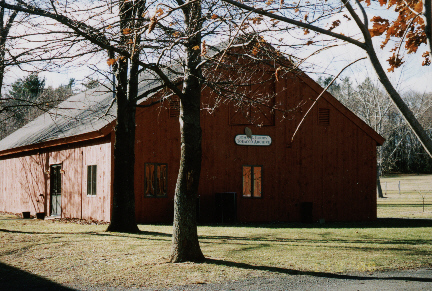Contents
|
|
|
Martin Luther King, Jr. in
Simsbury
Highlights of Summer Research - 2000
Collected by Pam McDonald, Westminster School, Simsbury, CT
In partial fulfillment of her Master of Library Science Degree
from Syracuse University
Supervised by Stephen Simon - Simsbury Historical Society
|
Basic Background
When the United State began fighting in World War II, a serious labor
shortage occurred because workers who normally filled these jobs either
went off to war, or were employed in manufacturing establishments which
were primarily producing goods for use in the war effort. As a result,
there was a serious shortage of agricultural labor in Connecticut.
Virtually all of Connecticut’s farmers, particularly those who grew
the labor intensive tobacco crop, established new sources of migrant
labor in order to address this extreme labor shortage. Agreements were
made with the Jamaican government to import hundreds of Jamaicans as
temporary workers. Local families were encouraged to send their
children, 14 years and older, to work in the fields, including the
tobacco fields, to help with the war effort. Young women from West
Virginia, Pennsylvania, and other states were brought in to work
primarily in the tobacco barns. One sizable group of young women from
Florida lived in a dormitory specially built for them in Tariffville.
Morehouse College was among the southern black colleges that recruited
young African -American men, mostly their own students, to ride the
train north to work on tobacco farms in Connecticut in order to earn
college tuition money. The colleges usually sent professors with the
students, who were paid to supervise the young men.
Martin Luther King, Jr. was one of the many students who participated
in this Morehouse College program during the war in 1944, when he was 15
and about to enter Morehouse College as a Freshman, and again after the
war in 1947, when he was 18 and about to enter his Senior year at
Morehouse College.
Morehouse students who worked for Cullman Brothers could live in one
of three Cullman Brothers "camps" or dormitories: Morehouse
College and Hoskins Station, both north and west of the center of
Simsbury, and Indian Head near Bill’s Greenhouse off Route 189 in
Granby.
Highlights
1943 and 1947 were probably two very different sets of experiences
for the Morehouse students including Martin Luther King, Jr.. Certain
specific facts documented by newspaper accounts, as well as a lack of
public evidence about Martin Luther King, Jr.’s 1947 experience
suggest clear differences.
1944
• The United States was in the midst of World War II.
• The year before had seen 8 race riots* in large American
cities whereas, before 1943 it was unusual to have even one race
riot in a year’s time.
• Concern for racial harmony and a smoothly operating social
order was palpable and understandable because of the need to have a
cooperative citizenry in order to win World War II and because there
was concern that African American unrest was increasing.
• By 1944, the Connecticut Council of Churches had started an
ambitious recreational program primarily for Jamaicans and African
American students from southern colleges who were brought to
Connecticut to help cultivate and harvest Connecticut tobacco. These
recreational programs provided ping-pong, library books, pianos, and
movies that were brought to perhaps dozens of agricultural
dormitories throughout the state for the use of migrant workers. A
Glee Club program was organized in which African-American and white
musical directors visited migrant dormitories to prepare programs of
Negro spirituals. These programs were performed for local
communities, usually during church services, and for an annual
national broadcast from The Hartford Times Portico on WHTH
radio.
• Connecticut’s year-old Inter-Racial Commission, established
through the legislative efforts of Governor Baldwin and chaired by
the dynamic Bishop Gray, continued to investigate incidents of
racial discrimination in Connecticut. Although the commission did
not see itself as an enforcement agency, members of the commission
typically did inform violators of their lack of adherence to the law
and violators often changed their policies as a result of this
communication.
• Popular movies were shown at Eno Memorial Hall on Fridays,
Saturdays and Sundays throughout the summer. The year before,
Connecticut’s Inter-Racial Commission appears to have requested
that the operator of the theater disallow racially discriminatory
seating practices initiated by an employee. As a result, the
Morehouse students of 1944 appear to have attended movies there
without a hint of racial segregation.
1947
• In contrast to the weekly notices of the movie schedule at
Eno Memorial Hall in 1944, there are no advertisements for movies at
Eno Memorial Hall in 1947. This lack strongly suggests that movies
are no longer being shown at Eno, certainly not during the summer of
1947. In fact, the theater operator, by this time, has become the
vice-president and treasurer of the Morse School of Business. In
addition, the Methodist church buys a movie projector with the
intention of showing movies as entertainment.
• The lack of news about the Connecticut Council of Churches
Recreational program in the Lasbury scrapbooks, The Hartford
Times and the lack of any mention of southern African-American
college student Glee Club performances in Simsbury churches suggests
that the Council Recreational program is no longer operating in
1947. However, the migrant worker girls from Florida do perform at
the Simsbury Congregational Church under the direction of the church’s
choir director.
• An unusual notice on the front page of a July issue of the Farmington
Valley Herald announces that the Farmington River,
coincidentally at the point where it comes nearest to the Hoskins
Station dormitory where Martin Luther King, Jr. is likely to have
lived in 1944, and perhaps in 1947, is polluted. The article
explains that the on-site pollution notice had been reposted, a hole
in the fence had been repaired and that anyone swimming there would
be prosecuted. There is a peculiar lack of explanation as to what
might be causing the pollution or how it might be a danger to the
public.
Intriguing Directions for Further Research
• Scholars and friends of Martin Luther King, Jr. generally agree
that Martin Luther King, Jr.'s first summer in Simsbury gave him
evidence that the strict segregation of the South was not inevitable,
and that another, far freer relationship among the races was possible.
Did Martin Luther King’s second summer in Simsbury alert him to the
urgency of addressing racism before the Southern style of segregation
overtook the North?
• In which dormitory did Martin Luther King, Jr. live? Was it the
Morehouse College Camp at the corner of Barn Door Hills Road and
Firetown Road? Or was it Hoskins Station on Hoskins Road, about .5 miles
from Route 10? Circumstantial evidence suggests that he lived at Cullman
Brother’s Farm # 2 called Hoskin’s Station, which still stands
today.
1. Reverend Hayes does not remember him even though they would
have lived and worked together for an entire summer and even though
Hayes met King in later years in Hartford.
2. The Morehouse Camp residents do not appear to have
participated in the Connecticut Council Glee Club events according
to newspaper accounts, however, Hoskins Station residents did
participate, and so did Martin Luther King, Jr. according to a
letter to his parents.
• Which Simsbury churches did Martin Luther King, Jr. attend? There
is evidence that Morehouse College students attended both the First
Congregational Church and the United Methodist Church. Did they perform
at, or attend, any other Simsbury churches, in Tariffville, for example?
Was Martin Luther King, Jr. among them?
• Reading Martin Luther King, Jr.’s brief account of his feelings
as he rode on the train north of Washington D. C., as he visited
Hartford and as he lived in Simsbury, as well as hearing Dr. Picken’s
account of his experience as a southern African-American youth
traveling, working and finding entertainment in the North, strongly
suggest that the discontinuity between their experiences of racism in
the North and in the South, were profoundly felt. To what extent did
Martin Luther King, Jr.’s summers in Simsbury influence his life’s
direction by proving the possibility of a different relationship among
the races?
• Martin Luther King, Jr., as the son of a popular preacher in a
large city, was economically advantaged and certainly well-respected in
southern African American society. Not all participants in the program
were from the city, nor were they all as well-off as Martin Luther King,
Jr.. In addition, when Martin Luther King, Jr. went to Hartford for
Sunday services, he was likely to have been invited into the homes of
parishioners for Sunday dinner, as were many other Morehouse students.
To what extent was Martin Luther King, Jr. influenced to be more
compassionate of African Americans of different economic and cultural
backgrounds, by his close association with African-Americans in various
working and relaxing circumstances?
• If the Martin Luther King, Jr.’s two summers in Simsbury where
as different as they appear to have been, did this apparent
deterioration of inter-racial harmony spur him on to realize that action
on the issues of race had to be taken sooner rather than later in order
to halt a further erosion of rights and respect?
Original Purpose of the Research
• Can it be proven, as the 1992 newspaper article by Cockerham
claims, that the Inter-Racial Commission asked Raymond Joyce to sign
a statement promising not to allow discrimination against migrant
workers when they attended movies at Eno Memorial Theater the year
before Martin Luther King Jr, would have attended movies there? A
similar account in the Inter-Racial Commission’s second newsletter
tends to corroborate the story. However, the actual statement, or a
detailed account of the incident that would prove it with reasonable
certainty, has not yet been found.
• Did Martin Luther King, Jr. attend movies at Eno Memorial
Theater? Other Morehouse students clearly did attend movies there
according to many Simsbury resident witnesses who remember the time.
Certainly Morehouse students of the era remember enjoying time spent
in Simsbury’s center.
|
Copyright Pam McDonald, 2007
|
|




